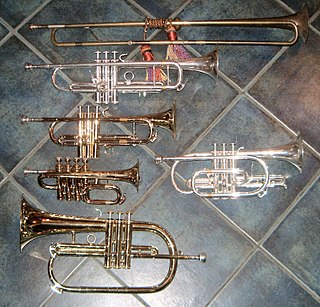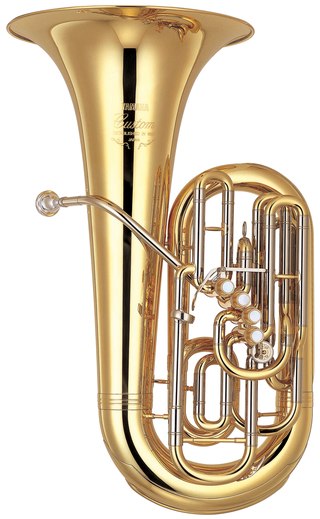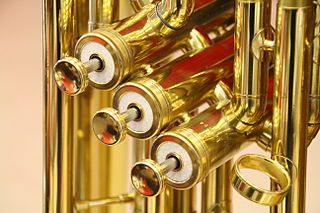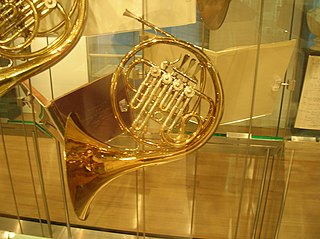
A brass instrument is a musical instrument that produces sound by sympathetic vibration of air in a tubular resonator in sympathy with the vibration of the player's lips. The term labrosone, from Latin elements meaning "lip" and "sound", is also used for the group, since instruments employing this "lip reed" method of sound production can be made from other materials like wood or animal horn, particularly early or traditional instruments such as the cornett, alphorn or shofar.

The cornet is a brass instrument similar to the trumpet but distinguished from it by its conical bore, more compact shape, and mellower tone quality. The most common cornet is a transposing instrument in B♭. There is also a soprano cornet in E♭ and cornets in A and C. All are unrelated to the Renaissance and early Baroque cornett.

The flugelhorn, also spelled fluegelhorn, flugel horn, or flügelhorn, is a brass instrument that resembles the trumpet and cornet, but has a wider, more conical bore. Like trumpets and cornets, most flugelhorns are pitched in B♭, though some are in C. It is a type of valved bugle, developed in Germany in the early 19th century from a traditional English valveless bugle. The first version of a valved bugle was sold by Heinrich Stölzel in Berlin in 1828. The valved bugle provided Adolphe Sax with the inspiration for his B♭ soprano (contralto) saxhorns, on which the modern-day flugelhorn is modelled.

The French horn is a brass instrument made of tubing wrapped into a coil with a flared bell. The double horn in F/B♭ is the horn most often used by players in professional orchestras and bands, although the descant and triple horn have become increasingly popular. A musician who plays a horn is known as a horn player or hornist.

The pitch of a brass instrument corresponds to the lowest playable resonance frequency of the open instrument. The combined resonances resemble a harmonic series. The fundamental frequency of the harmonic series can be varied by adjusting the length of the tubing using the instrument's valve, slide, key or crook system, while the player's embouchure, lip tension and air flow serve to select a specific harmonic from the available series for playing. The fundamental is essentially missing from the resonances and is impractical to play on most brass instruments, but the overtones account for most pitches.

The trombone is a musical instrument in the brass family. As with all brass instruments, sound is produced when the player's vibrating lips cause the air column inside the instrument to vibrate. Nearly all trombones use a telescoping slide mechanism to alter the pitch instead of the valves used by other brass instruments. The valve trombone is an exception, using three valves similar to those on a trumpet, and the superbone has valves and a slide.

The trumpet is a brass instrument commonly used in classical and jazz ensembles. The trumpet group ranges from the piccolo trumpet—with the highest register in the brass family—to the bass trumpet, pitched one octave below the standard B♭ or C trumpet.

The tuba is the largest and lowest-pitched musical instrument in the brass family. As with all brass instruments, the sound is produced by lip vibration – a buzz – into a mouthpiece. It first appeared in the mid-19th century, making it one of the newer instruments in the modern orchestra and concert band, and largely replaced the ophicleide. Tuba is Latin for "trumpet".

A transposing instrument is a musical instrument for which music notation is not written at concert pitch. For example, playing a written middle C on a transposing instrument produces a pitch other than middle C; that sounding pitch identifies the interval of transposition when describing the instrument. Playing a written C on clarinet or soprano saxophone produces a concert B♭, so these are referred to as B♭ instruments. Providing transposed music for these instruments is a convention of musical notation. The instruments do not transpose the music; rather, their music is written at a transposed pitch. Where chords are indicated for improvisation they are also written in the appropriate transposed form.

The bass trumpet is a type of low trumpet which was first developed during the 1820s in Germany. It is usually pitched in 8' C or 9' B♭ today, but is sometimes built in E♭ and is treated as a transposing instrument sounding either an octave, a sixth or a ninth lower than written, depending on the pitch of the instrument. Having valves and the same tubing length, the bass trumpet is quite similar to the valve trombone, although the bass trumpet has a harder, more metallic tone. Certain modern manufacturers that sell 'valve trombones' and 'bass trumpets' employ the same tubing, valves, and bell in different combinations; in these circumstances, the bass trumpet is nearly similar to the valve trombone.

The mellophone is a brass instrument used in marching bands and drum and bugle corps in place of French horns. It is a middle-voiced instrument, typically pitched in the key of F, though models in E♭, D, C, and G have also historically existed. It has a conical bore, like that of the euphonium and flugelhorn. It can also be used to play French horn parts in concert bands and orchestras.

The natural horn is a musical instrument that is the predecessor to the modern-day (French) horn. Throughout the seventeenth and eighteenth centuries, the natural horn evolved as a separation from the trumpet by widening the bell and lengthening the tubes. It consists of a mouthpiece, long coiled tubing, and a large flared bell. This instrument was used extensively until the emergence of the valved horn in the early 19th century.

The keyed trumpet is a cylindrical-bore brass instrument in the trumpet family that makes use of tone holes operated by keys to alter pitch and provide a full chromatic scale, rather than extending the length of tubing with a slide or valves. It was developed from the natural trumpet in the 18th century and reached its high-point in popularity c. 1800 when two important trumpet concertos were written for it by Austrian composers Joseph Haydn and Johann Nepomuk Hummel, but waned with the invention of valves in the 1820s and the subsequent emergence of the modern valved trumpet. It is rarely seen in modern performances.

A natural trumpet is a valveless brass instrument that is able to play the notes of the harmonic series.

Marching brass instruments are brass instruments specially designed to be played while the player is moving. Not all instruments have a corresponding marching version, but many do, including the following:
The baroque trumpet is a musical instrument in the brass family. Its designed to allow modern performers to imitate the natural trumpet when playing music of that time, so it is often associated with it. The term 'baroque trumpet' is often used to differentiate an instrument which has added vent holes and other modern compromises, from an original or replica natural trumpet which does not. Notable baroque trumpet players include Alison Balsom, Niklas Eklund, Brian Shaw, and Caleb Hudson.
The Vienna horn is a type of musical horn used primarily in Vienna, Austria, for playing orchestral or classical music. It is used throughout Vienna, including the Vienna Philharmonic and Wiener Staatsoper.

Brass instrument valves are valves used to change the length of tubing of a brass instrument allowing the player to reach the notes of various harmonic series. Each valve pressed diverts the air stream through additional tubing, individually or in conjunction with other valves. This lengthens the vibrating air column thus lowering the fundamental tone and associated harmonic series produced by the instrument. Valves in brass instruments require regular maintenance and lubrication to ensure fast and reliable movement.

A horn is any of a family of musical instruments made of a tube, usually made of metal and often curved in various ways, with one narrow end into which the musician blows, and a wide end from which sound emerges. In horns, unlike some other brass instruments such as the trumpet, the bore gradually increases in width through most of its length—that is to say, it is conical rather than cylindrical. In jazz and popular-music contexts, the word may be used loosely to refer to any wind instrument, and a section of brass or woodwind instruments, or a mixture of the two, is called a horn section in these contexts.

The German horn is a brass instrument made of tubing wrapped into a coil with a flared bell, and in bands and orchestras is the most widely used of three types of horn, the other two being the French horn and the Vienna horn. Its use among professional players has become so universal that it is only in France and Vienna that any other kind of horn is used today. A musician who plays the German horn is called a horn player. The word "German" is used only to distinguish this instrument from the now-rare French and Viennese instruments. Although the expression "French horn" is still used colloquially in English for any orchestral horn, since the 1930s professional musicians and scholars have generally avoided this term in favour of just "horn". Vienna horns today are played only in Vienna, and are made only by Austrian firms. German horns, by contrast, are not all made by German manufacturers, nor are all French-style instruments made in France.

















